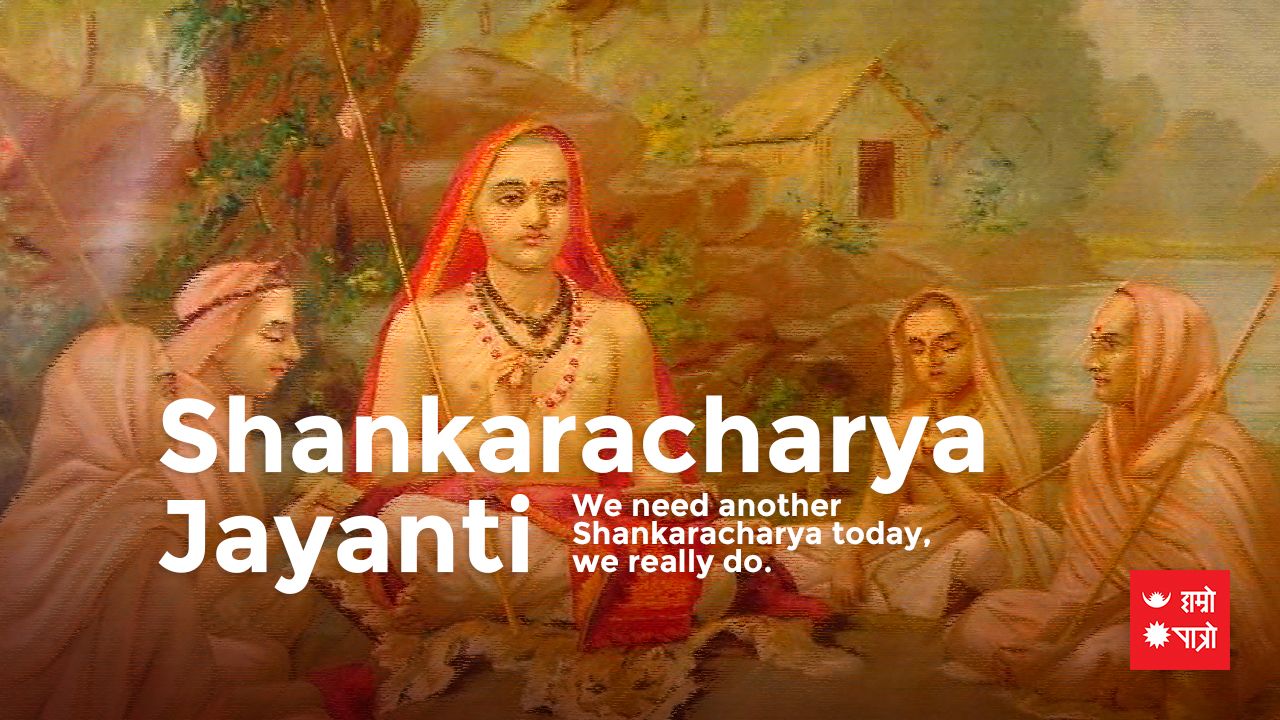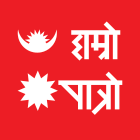Upcomming Events
-
6JesthaMohini Ekadashi Vrata today
-
7JesthaSom Pradosh Vrata tomorrow
-
8JesthaNrisingha Jayanti 2 days remaning
-
9Jestha
-
10Jestha
-
15JesthaNational Republic Day 9 days remaning
-
17JesthaGorakhkali Puja 11 days remaning
-
18JesthaWorld No Tobacco Day 12 days remaning
-
19JesthaGlobal Day Of Parents 13 days remaning
-
20JesthaApara Ekadashi Vrata (Smarta)/Chittadhar Hridaya Janma Jayanti 14 days remaning
-
21Jestha
-
22Jestha
-
23JesthaSithi Cha: Hre/World Environment Day 17 days remaning
-
24JesthaBata sabitri Vrata/Shani Jayanti Vrata 18 days remaning
-
25JesthaGosaikunda Snan Aarambha/Dasahara Snan Arambha 19 days remaning
-
27JesthaRashtriya Krishak Diwas 21 days remaning
-
30JesthaSithi Nakha/World Day Against Child Labour 24 days remaning
-
32JesthaGorakhkali Puja/World Blood Donor Day 26 days remaning
-
1AashadhaMithun Sankranti/World Elder Abuse Awareness Day 27 days remaning
-
2Aashadha
-
3Aashadha
-
4AashadhaNirjala Ekadashi Vrata (Vaisnav) 30 days remaning
-
5Aashadha
-
6AashadhaWorld Refugee Day 32 days remaning
-
7AashadhaPoornima Vrata/World Yoga Day/ Music Day 33 days remaning
-
8AashadhaJya: Punhi/Kabir Jayanti 34 days remaning
-
9AashadhaInternational Widows Day 35 days remaning
-
11AashadhaMangal Chauthi Vrata/Bhumi Pooja 37 days remaning
-
12AashadhaInternational Day against Drug Abuse and Illicit Trafficking 38 days remaning
-
15AashadhaDahi chiura Khane Din/ Rashtriya Dhan Diwas/Gorakhkali Puja 41 days remaning
-
17AashadhaInternational Cooperative Day 43 days remaning
-
18AashadhaYogini Ekadashi Vrata/World Sports Journalist Day 44 days remaning
-
19AashadhaPradosh Vrata 45 days remaning
-
22AashadhaWorld Population Day 48 days remaning
-
29AashadhaBhanu Jayanti/Surya Pooja 55 days remaning
-
30AashadhaGorakhkali Puja 56 days remaning
-
31AashadhaWorld Youth Skill Day 57 days remaning
-
1Shrawan
-
2ShrawanHarishayani Ekadashi Vrata/Chaturmaas Wrata Aarambha 59 days remaning
-
3ShrawanPradosh Vrata 60 days remaning
Jyotish
-
Jyotish Dr. Janak Bhattaविगत ३५ वर्षदेखि कुण्डली निर्�...
-
Jyotish Mukunda Sharmaस्वाध्याय, सत्सङ्ग र सदाचारजस�...
-
Jyotish Dipendra Khatiwadaसम्पुर्णानन्द संस्कृत बिश्वब...
-
Jyotish Damodar Kaushikज्योतिष र व्याकरण विषयमा आचार�...
-
Jyotish Smarika Acharyaबाल्मीकि बिद्यापिठ बाट ज्योत�...
-
Jyotish Ghanashyam Pokharelनेपाल संस्कृत विश्वविद्यालयब...
-
Acharya Choodamani Pathakसम्पूर्णानन्दसंस्कृत विश्वव�...
-
Jyotish Vaman Sapkotaशिक्षा - व्याकरणाचार्य, पौरोही...
-
Jyotish hamropatrojyotish of nepal
-
Jyotish Khagendra Subediसम्पूर्णानंद संस्कृत विश्ववि...
-
Jyotish Narayan Prasad Dulalसम्पूर्णानन्द संस्कृत विश्वव...
-
Jyotish Khageshwor Subediगुरुकुल पद्दति बाट ज्योतिषीय �...
-
Jyotish Mohan Ghimireसम्पुर्णानन्द संस्कृत विश्वव...
-
Jyotish Narayan Prasad Gautamगुरुकुल शिक्षा प्रणालीबाट ज्�...
-
Hamro Patro JyotishI am test jyotish please donot call.
-
Jyotish Purushottam Ghimireनेपाल संस्कृत विश्वविद्यालय, �...
-
Jyotish Damodar Poudelनेपाल संस्कृत विश्व बिद्यालय�...
-
Jyotish Deepak Prasad Kafleसम्पूर्णानन्द संस्कृत विश्वव...
वैशाख शुक्ल पञ्चमी
Ramanujacharya Jayanti । Aadhyaguru Shankarachaarya Jayanti । International Nurses Day

Ramanucharya Jayanti
Who is Ramanucharya?
The birth anniversary of Ramanucharya, a devotee of Vishnu, is celebrated on this date every year. Like Shankaracharya, Ramanucharya is an eternal philosopher, although Ramanucharya's philosophies are Vishnu-centric. He was born in 1017 AD in the ancient city of Madras. He came to Kancheepuram in pursuit of Veda's study; he studied Adwita Vedanta under teacher Yadav Prakash.
Let's honor this Guru, Ramanuja Acharya, on his birthday. He is a revered guru in the Bhakti-Marga lineage. He also initiated Bhakti poetry and the saints of Alvar poetry. His mantra was "Om Namo Narayana," and his utmost belief was in a monotheistic manifest where Lord Vishnu was the center.
Ramanucharya, a campaigner for the Bhakti campaign, is also considered a guide for Vaishnavism.
His contributions
He wrote his commentary on the Brahma Sutra, which is known as the Sri Bhasya. He was a profound scholar of the Sanskrit language, and he also crafted Srimad Bhagwat Geeta in the Sanskrit language. He traveled across the length and breadth of the Indian subcontinent to disseminate the path of wisdom and reformation. He is also known for his balanced verdict on the dispute between Vaisnavism and Saivism.
We need more Ramanujacharyas in this world; May Bhakti magnify across the globe.
Shankaracharya Jayanti: We need another Shankaracharya today, we do
Who is Shankaracharya ?
Jagatguru Adi Shankaracharya is a champion thinker and a charmer, an unchallenged king of Santana philosophy who appeared right on time when the entire world was sunk in a quagmire of superstitions and scriptural misinterpretations.Shankaracharya also represents the most riotous sardonicism in the universe of philosophy, he is turned hidden Buddhist by Vedantic, and Buddhist curse him for ending the wave of Buddhism in the Indian subcontinent and reestablish Vedas.
However, a single person who only lived till his mid-thirties was able to study Vedas, interpret them, reinterpret them, and travel across the Indian subcontinent organized debates and created a balance in society through delivering the knowledge of Vedas. His philosophical prowess satisfied the Vedic scholars and his sharp intellect and magical articulation defeated his philosophical rivalries. Layman was hugely pleased by his simple yet pious way of devotion, his bhajans mesmerized the crowds and the Sanatan Philosophy was reestablished with all its glory. I still can't figure out why some historians and writers blamed him as a hidden Buddhist, plausibly this could be because he redeemed falsely imposed worthless priests and ended the academic imperils of Sanatan manifest.
The contribution of Adi Guru Shankaracharya.
To understand the herculean contribution made by Jagatguru, we must go back to the 8th century CE, The religious and spiritual essence was rampant during that time, and rigid and exploitive ritualism was highly prevailing in society. Because of this rigid and exploitive ritualism, rejecting Vedas and accepting Buddhism was happening, villages and cities were transforming into anti-Sanatan ideas and the religious and spiritual transition was creating a huge wave of Buddhism into the Indian subcontinent. The essence of Sanatan philosophy, with its all-embracing message of love, compassion, and pervasiveness of humankind, was completely lost in the blind ritualistic performance.
Disliked by Buddhists.
On the other side, Buddhists curse him for ending the wave of expanding Buddhism, but that is nothing but a conspiracy. I belong to Nepal, which is the world's only Hindu capital (the former world's only Hindu Kingdom), but an exclusive spiritual land that holds a mesmerizing mixture of Hinduism and Buddhism. We have temples and idols where the same idols or statues are named after different gods of Hindu and Buddhist philosophies. Buddha is worshiped equally as other Hindu deities and gods. The ancient pond in Kathmandu valley is believed to have been cut by the Buddhist deity "Majushree," and people from both faiths worship him. An idol at Pashupati is worshiped as Manjushree by Buddhists; however, the same idol is worshipped as "Saraswoti" by Hindus. This harmony and integration were commenced and institutionalized by Jagatguru, who redefined Bhakti as a tool to achieve eternal oneness with the ultimate energy.
Shankaracharya started writing major commentaries on scriptural texts at the age of 12 and concluded his every commentary and redefinition by the age of 16, was a true son of God, an incarnation sent to reestablish and reconstruct the spiritual and religious essence of society. He expanded the narrow philosophies and drab systems of worship, established 4 ashrams in 4 corners of India, and institutionally placed his four disciples to propagate Advita through them. These Aashramsare the institutions that still institutionalize and safeguard Sanatan philosophies and construct researches and sastrathas. Let me say a million words, but still, they will not complete the article on the contribution of Jagat Guru. I must say that I am not bringing his birth, family, or village into today's context. Jagaturu must not be confined to all these minimal identifications; an incarnation of Lord Shiva only lived for 32 years and achieved all these.
Happy birth anniversary to Jagatguru, We need another Shankaracharya today.
International Nurses Day
Background of International Nurses Day
Today, the world is celebrating International Nurses' Day on the occasion of the birth of the great Florence Nightingale, a nurse who made an unprecedented contribution to modern medicine, that is, the beginning of the professional health care and added a new height to care and cure. Florence is also known as A Lady with a Lamp, meaning a woman carrying a tuki or lantern.
During the Crimean War in Europe at that time, the soldiers who were working day and night to treat the wounded soldiers called her Lady with a Lamp with respect. Florence Nightingale, the world's first nurse to reach out to patients at night, has also set up the world's first private nursing school at Thomas Hospital in London, UK, which is still operating a non-profit organization.
Florence has brought the modern nursing profession as a deep service concept in keeping the hospital clean and respecting the feelings and verdicts of the patients. The world celebrates Nurses' Day on May 12 each year, discussing Florence's contribution. The nursing profession has been held in high esteem by people all over the world for the past century. Nurses wearing white coats, ribbons on their hair, medicines, and health care providers with smiles. The nurse reminds me of the hospital and the main thing is health care and loving care, doesn't it?
While the world is discussing Florence's contribution, let's get down to business, Isn't it, in Nepal's nursing history?
Theme 2024
The economic power of care which creates healthy people and societies and drives healthy economies, will be highlighted by the International Council of Nurses (ICN) on International Nurses' Day (IND) 2024 under the theme: Our Nurses. Our Future. The economic power of care
A Brief History of Nursing in Nepal
We can't imagine a hospital without a nurse. After the establishment of Bir Hospital in 1947AD, there were only a few compounders as health assistants and only a handful of people trained in India. During that time at Bir hospital, dressings and other treatments were done by the compounder or the doctor themselves. The Nepali history of nursing seems to have started in 2013 BS when Nepali students, including some housewives, were formally trained as nurses.
It is believed that the beginning of nursing in Nepal was due to the importance of health care and nursing in the aristocratic family during the Rana regime. During the Rana period, four Nepali women, Bidhavati Kansakar, Radha Devi Malakar, Dharmadevi Kansakar, and Bishnu Devi Rai, have a history of training as health assistants from Allahabad, India. After that, the trend of Nepali women going to India for 4 years and 9 months long nursing courses has gradually increased. Today, the presence of nurses in hospitals and clinics across the street can be seen in large numbers. Numerous nursing colleges have opened in cities and it is becoming more and easier to go abroad, so the attraction towards nursing is increasing. The amazing thing about nursing is that there are only a handful of men in this profession, some time ago, some nursing colleges also provided nursing training to men, but later men were not attracted to this profession. Perhaps the sweet presence of women in this business of love, affection, and care seems to be the best. The Florence Nightingale Medal is considered to be the highest degree in the nursing profession, meaning that the Florence Nightingale is a source of inspiration for every nurse.
A poem on Florence written by a soldier
Florence is not only a philanthropist but also a prolific writer, whose books on medical treatment are so simple in English language and illustrations that anyone can easily understand. A wounded soldier in the Crimean War wrote a poem about Florence, presenting that poem, before hitting the whip of special material on this day, just here:
Lo! in that house of misery
A lady with a lamp I see
Pass through the glimmering gloom,
And flit from room to room
-Suyog Dhakal
Upcomming Events
-
6JesthaMohini Ekadashi Vrata today
-
7JesthaSom Pradosh Vrata tomorrow
-
8JesthaNrisingha Jayanti 2 days remaning
-
9Jestha
-
10Jestha
-
15JesthaNational Republic Day 9 days remaning
-
17JesthaGorakhkali Puja 11 days remaning
-
18JesthaWorld No Tobacco Day 12 days remaning
-
19JesthaGlobal Day Of Parents 13 days remaning
-
20JesthaApara Ekadashi Vrata (Smarta)/Chittadhar Hridaya Janma Jayanti 14 days remaning
-
21Jestha
-
22Jestha
-
23JesthaSithi Cha: Hre/World Environment Day 17 days remaning
-
24JesthaBata sabitri Vrata/Shani Jayanti Vrata 18 days remaning
-
25JesthaGosaikunda Snan Aarambha/Dasahara Snan Arambha 19 days remaning
-
27JesthaRashtriya Krishak Diwas 21 days remaning
-
30JesthaSithi Nakha/World Day Against Child Labour 24 days remaning
-
32JesthaGorakhkali Puja/World Blood Donor Day 26 days remaning
-
1AashadhaMithun Sankranti/World Elder Abuse Awareness Day 27 days remaning
-
2Aashadha
-
3Aashadha
-
4AashadhaNirjala Ekadashi Vrata (Vaisnav) 30 days remaning
-
5Aashadha
-
6AashadhaWorld Refugee Day 32 days remaning
-
7AashadhaPoornima Vrata/World Yoga Day/ Music Day 33 days remaning
-
8AashadhaJya: Punhi/Kabir Jayanti 34 days remaning
-
9AashadhaInternational Widows Day 35 days remaning
-
11AashadhaMangal Chauthi Vrata/Bhumi Pooja 37 days remaning
-
12AashadhaInternational Day against Drug Abuse and Illicit Trafficking 38 days remaning
-
15AashadhaDahi chiura Khane Din/ Rashtriya Dhan Diwas/Gorakhkali Puja 41 days remaning
-
17AashadhaInternational Cooperative Day 43 days remaning
-
18AashadhaYogini Ekadashi Vrata/World Sports Journalist Day 44 days remaning
-
19AashadhaPradosh Vrata 45 days remaning
-
22AashadhaWorld Population Day 48 days remaning
-
29AashadhaBhanu Jayanti/Surya Pooja 55 days remaning
-
30AashadhaGorakhkali Puja 56 days remaning
-
31AashadhaWorld Youth Skill Day 57 days remaning
-
1Shrawan
-
2ShrawanHarishayani Ekadashi Vrata/Chaturmaas Wrata Aarambha 59 days remaning
-
3ShrawanPradosh Vrata 60 days remaning
Jyotish
-
Jyotish Dr. Janak Bhattaविगत ३५ वर्षदेखि कुण्डली निर्�...
-
Jyotish Mukunda Sharmaस्वाध्याय, सत्सङ्ग र सदाचारजस�...
-
Jyotish Dipendra Khatiwadaसम्पुर्णानन्द संस्कृत बिश्वब...
-
Jyotish Damodar Kaushikज्योतिष र व्याकरण विषयमा आचार�...
-
Jyotish Smarika Acharyaबाल्मीकि बिद्यापिठ बाट ज्योत�...
-
Jyotish Ghanashyam Pokharelनेपाल संस्कृत विश्वविद्यालयब...
-
Acharya Choodamani Pathakसम्पूर्णानन्दसंस्कृत विश्वव�...
-
Jyotish Vaman Sapkotaशिक्षा - व्याकरणाचार्य, पौरोही...
-
Jyotish hamropatrojyotish of nepal
-
Jyotish Khagendra Subediसम्पूर्णानंद संस्कृत विश्ववि...
-
Jyotish Narayan Prasad Dulalसम्पूर्णानन्द संस्कृत विश्वव...
-
Jyotish Khageshwor Subediगुरुकुल पद्दति बाट ज्योतिषीय �...
-
Jyotish Mohan Ghimireसम्पुर्णानन्द संस्कृत विश्वव...
-
Jyotish Narayan Prasad Gautamगुरुकुल शिक्षा प्रणालीबाट ज्�...
-
Hamro Patro JyotishI am test jyotish please donot call.
-
Jyotish Purushottam Ghimireनेपाल संस्कृत विश्वविद्यालय, �...
-
Jyotish Damodar Poudelनेपाल संस्कृत विश्व बिद्यालय�...
-
Jyotish Deepak Prasad Kafleसम्पूर्णानन्द संस्कृत विश्वव...
Liked by:




















 Mesh
Mesh Brish
Brish Mithun
Mithun Karkat
Karkat  Singha
Singha  Kanya
Kanya Tula
Tula Brischik
Brischik Dhanu
Dhanu  Makar
Makar  Kumbha
Kumbha Meen
Meen